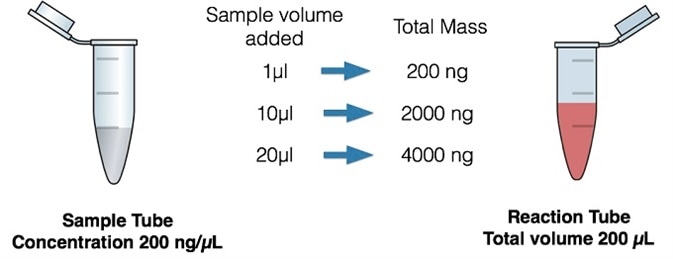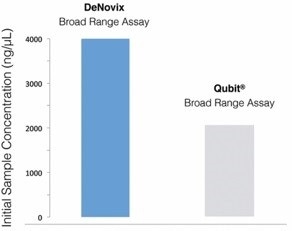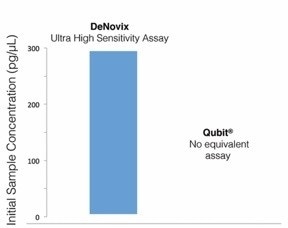Fluorescence methods allow specific and sensitive quantitation of biomolecules. Fluorophores are molecules that absorb light at one wavelength (excitation wavelength) and then emit light at another (emission wavelength). Certain fluorophore structures can be manipulated to fluoresce only when bound to a specific target molecule e.g. double-stranded DNA.
Fluorescence assays use this binding specificity to establish a direct correlation between the amount of fluorescence emitted by a sample and the concentration of the biomolecule of interest in solution. By mixing a fluorophore with a sample of known concentration and measuring the Relative Fluorescent Units (RFU), a relationship between concentration and measured RFU can be plotted and used as a standard curve.
The emission of the same fluorophore, bound to unknown samples, can then be plotted against this standard curve to determine the sample concentration. The binding specificity of the assays means that the influence of contaminants in the sample (including degraded nucleic acids or protein) on quantitative accuracy is minimized.
Concentration versus total mass
Fluorescent assays are optimized over a core assay range of total mass of sample that is defined by the chemistry of the assay and the spectral properties of the fluorophore. By varying the sample volume added to the assay, the range can be extended for some assays. The total mass of sample added should be within the range specified for that assay kit in order to obtain reliable and reproducible results.
Specifications based on common nomenclature must be reviewed when comparing reported concentration ranges for kits developed by different manufacturers. Three types of specifications may be reported:
- Initial sample concentration
- Concentration after dilution in the assay tube, or
- Total mass of target biomolecule in the assay tube

Figure 1. Effect of sample volume on total mass of DNA in an assay. Image credit: DeNovix
Example: Minimum kit concentration
An absolute mass of 100 pg in 200 μL results when 10 μL of the lowest initial sample concentration covered by a kit with a stated lower limit of 10 pg/μL is used. (This can also be expressed as 0.5 pg/μL following dilution in the assay tube.)
If the total mass per assay tube is not less than the lower specification equivalent, lower initial sample concentrations can be measured by increasing the volume (e.g. 20 μL of a 5 pg/μL sample).
Example: Maximum kit concentration
An absolute dsDNA mass of 250 ng in 200 μL results when 10 μL of the highest initial sample with a stated upper limit of 25 ng/μL is used. This can also be expressed as 1.25 ng/μL following dilution in the assay tube.
If the total mass per assay tube is not more than the upper specification equivalent, higher initial sample concentrations can be measured by decreasing the volume e.g. 1 μL of a 250 ng/μL sample).
DeNovix dsDNA Assay Kits.
Using three different fluorescence assays kits, DeNovix fluorescence assays allow dsDNA quantitation over an initial sample concentration range of 0.5 pg/µL to 4000 ng/µL. Each kit follows a simple mix-and-measure protocol with a simple, two-point standard curve.
- The DeNovix dsDNA Broad Range Assay is ideal for measuring sample concentrations ranging from 0.1 ng/μL to 2000 ng/μL, with an extended upper range to 4000 ng/μL.
- The DeNovix dsDNA High Sensitivity Assay is employed to measure sample concentrations ranging from 5 pg/μL to 250 ng/μL.
- The DeNovix dsDNA Ultra High Sensitivity Assay is optimized to provide unmatched quantitation sensitivity with a sample concentration range of 0.5 to 300 pg/mL. Methods such as laser capture dissection, single-cell applications, ChIP-Seq, circulating tumor cell analysis and other methods relying on low input amounts of DNA can benefit from accurate and specific quantitation.

Figure 2. Measurement Ranges of DeNovix dsDNA Fluorescence Quantification Kits. Image credit: DeNovix
Key Features of DeNovix Assays
- Widest Measurement Range available. Fewer dilutions or reruns required compared to other commonly used assays (see figure 3)
- Optimized to work with DeNovix instruments and compatible with readers with appropriate excitation and emission specifications.
- Compatible with microplate readers. Available in 1000 assay kit size for high throughput applications



Figure 3. Comparison of Assay Measurement Ranges of DeNovix and Qubit™ dsDNA Fluorescence Quantification Kits. Image credit: DeNovix
Conclusion
The DeNovix dsDNA Fluorescence Quantification Assays provide the greatest sensitivity and widest dynamic range available today. DeNovix offer three highly specific assay kits for a wide range of sample concentrations.
DeNovix kits selectively and accurately measure dsDNA even in the presence of common contaminants such as RNA, ssDNA or protein. Combine the specificity of fluorescence with the purity measurements of absorbance on our DS-11 FX range for the optimum sample QC procedure.
DS 11 Series | Spectrophotometer | Fluorometer
Other resources
About DeNovix, Inc.
WELCOME TO DENOVIX
Award-Winning products for Life Science
Our multi-award winning products include the Reviewers’ Choice Life Science Product of the Year and Platinum Seal awarded- DS-11 Series Spectrophotometer / Fluorometer and CellDrop™ Automated Cell Counter. CellDrop is the first instrument of its kind to Count Cells Without Slides. These powerful instruments integrate patented DeNovix technology with easy-to-use software designed by life scientists for life scientists.
Researchers tell us they love the industry leading performance, smart-phone-like operation, and the flexible connectivity of the instruments. When support is needed, the DeNovix team is here to help. DeNovix received the prestigious Life Sciences Customer Service of the Year based on independent reviews posted by scientists worldwide!
CellDrop: Sustainable laboratory product of the year
The CellDrop Automated Cell Counter has been awarded Sustainable Laboratory Product of the Year in the SelectScience® Scientists’ Choice Awards®!
CellDrop’s patented DirectPipette™ technology distinguishes it as the only cell counter to eliminate the need for cell counting slides. This innovation saves millions of single-use plastic slides from use and disposal each year.
Sponsored Content Policy: News-Medical.net publishes articles and related content that may be derived from sources where we have existing commercial relationships, provided such content adds value to the core editorial ethos of News-Medical.Net which is to educate and inform site visitors interested in medical research, science, medical devices and treatments.